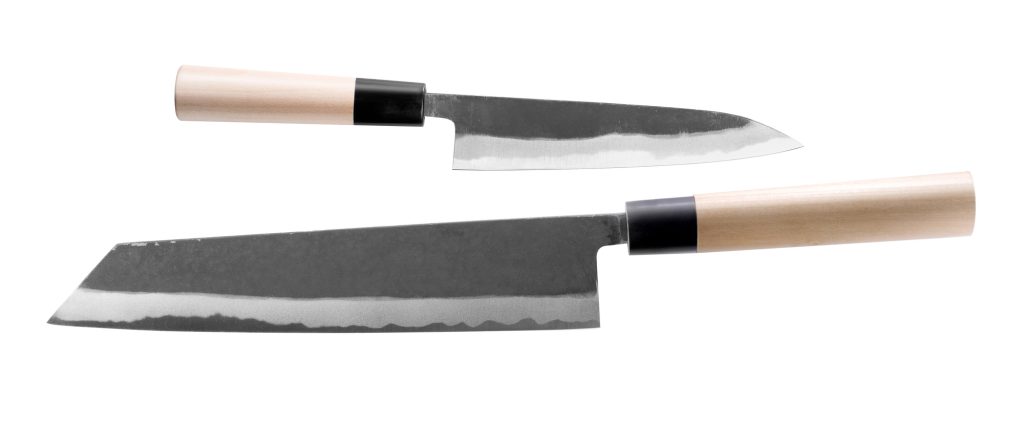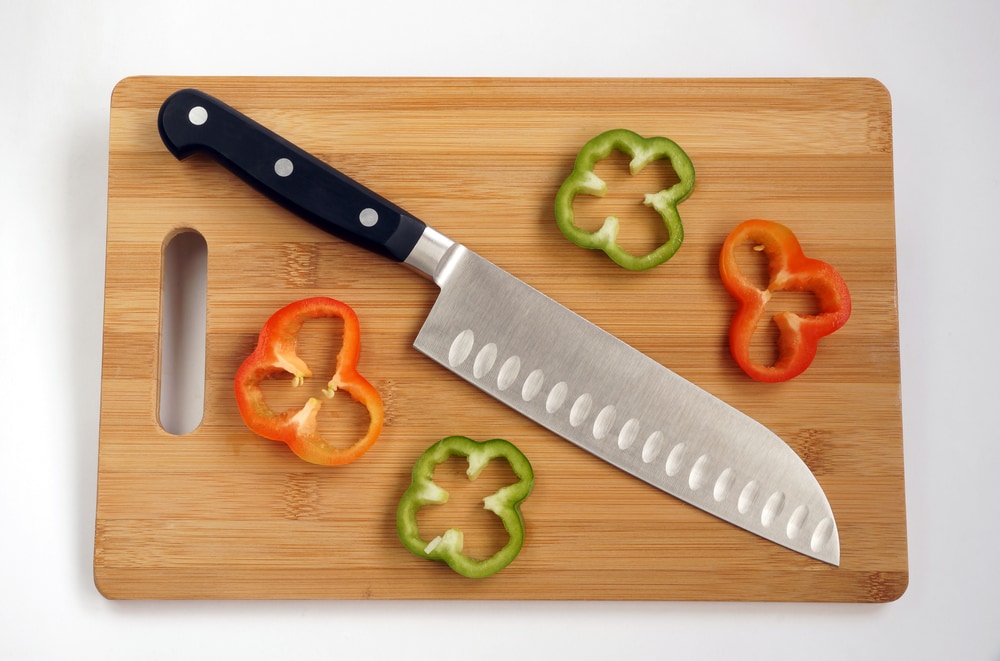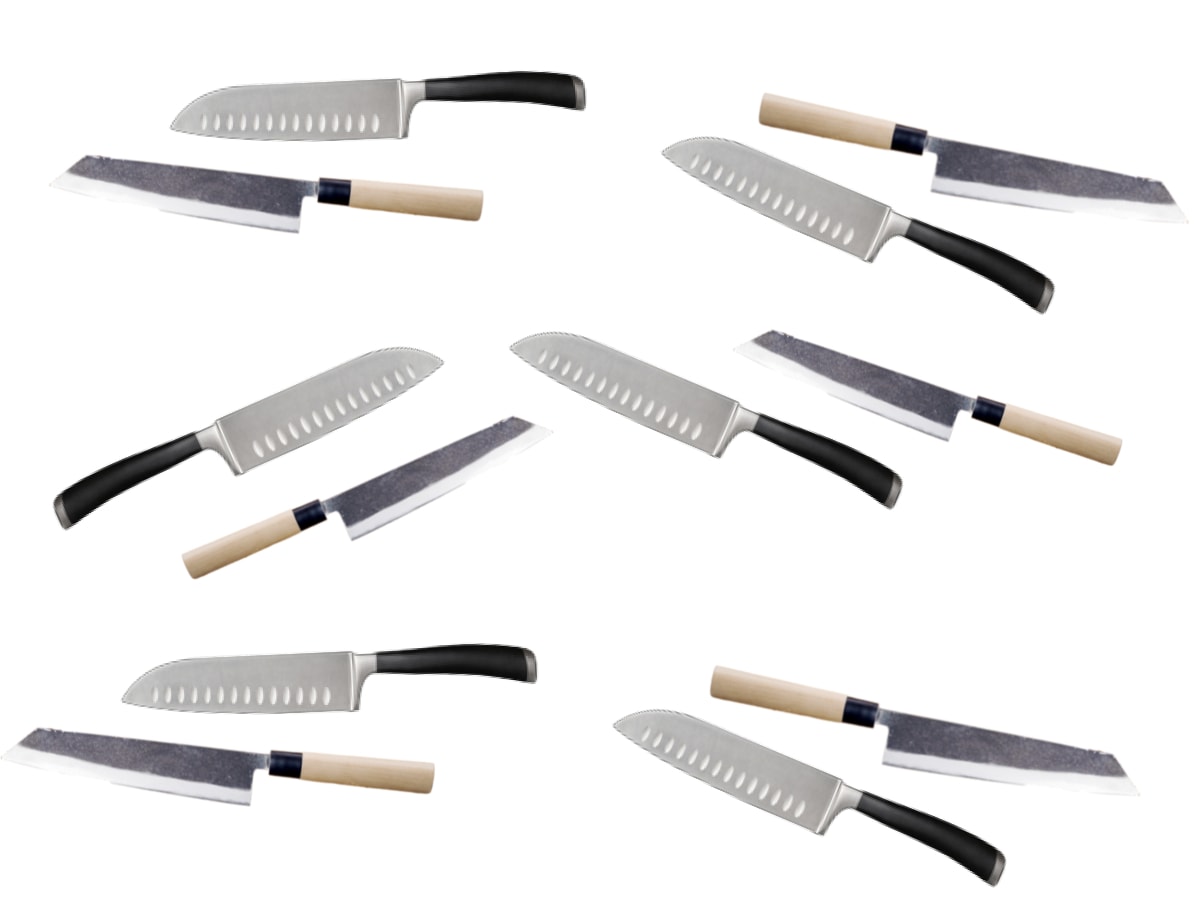The “western world” has a healthy culinary tradition. This legacy has produced some of the most versatile kitchen utensils available in 2022. That said, it can be easy for western-centrism to cloud our worldview. Japan, for instance, offers a wealth of alternatives that can be just as versatile as their western counterparts, if not more so.
Today, we’ll be discussing two types of knives in particular – Kiritsuke VS santoku. We’ll cover what each knife offers, why they’re excellent, and how to know which option is best for you. Read on to expand your horizons.
Kiritsuke Overview
As far as Japanese chef’s knives go, Kiritsuke knives are comparatively unknown. They’re a variant of the much more popular Gyuto knife. They feature a long, flat blade edge with a pointed tip. Some say they even resemble a small sword!
Kiritsuke knives are usually wicked sharp and excellent for a broad variety of kitchen tasks if you have the requisite skills. Anything from slicing vegetables to preparing raw fish to dicing meat is all possible with a Kiritsuke.

Shape
The long, flat blade of most Kiritsuke knives calls for an up-and-down chopping motion. If you’ve never used this kind of kitchen knife before, you may experience something of a learning curve. Don’t expect the balance and size to feel familiar right away.
Once you’ve mastered your tool, though, you should notice a huge improvement in your overall kitchen performance.
Ease of Use
Traditionally, Kiritsuke knives were reserved for only the most skilled chefs in a restaurant kitchen. The “mini sword” shape means that it can feel quite unwieldy to a beginner. It’s worth mentioning, however, that the sharpness and dexterity on offer here are unlike anything that many western chefs have experienced before.
If you’re a skilled chef, you’ll love a Kiritsuke knife.
Single-Bevel Sharpness
Traditional kiritsuke knives feature a single-bevel design. This typically allows for superior levels of sharpness as a single-sided blade allows for a much thinner edge overall, you might like to consider more modern double-beveled variants of kiritsuke knives.
Uses for Kiritsuke Knives
- Slicing long, raw fish
- Prepping vegetables
- Cutting through large amounts of softer meat
- General kitchen prep
Kiritsuke Basic Stats
- 9.5 – 13 inches long
- Blades 1 – 2 mm thick
- 59 – 63 HRC
Santoku Knife Overview
Santoku knives are known around the world for their versatility – it’s even in the name. “Santoku” means “three virtues” or “three uses”. Depending on who you ask, this is referring to either the three main kitchen tasks (cutting, slicing, and dicing) or the three staples of Japanese cuisine (meat, fish, and vegetables).
The shorter blade and exceptional balance of most santoku knives make them undeniably versatile in the kitchen.

Sheep’s Foot Shape
A defining characteristic of the santoku knife is its “sheep’s foot” shape. These tools feature a straight knife edge and a dull spine. The headline here is that this makes them super easy to handle and great for chopping tasks.
Ease of Use
The ubiquity of santoku knives should come as no surprise – they’re super easy to use. The blade length and overall size of these knives should feel fairly familiar to a chef who’s only ever used western chef’s knives before.
Whether you’re a novice or a professional chef, you should be able to find a santoku option that works for you.
Single or Double-Bevel Options
One point of difference here between Kiritsuke VS santoku knives is that it’s generally easier to find both single and double-bevel variants of santoku knives. Double-bevel options certainly exist for Kiritsuke, but they can be a rarer find.
A double-bevel can be more predictable to western chefs but offers less precision and sharpness overall.
Uses for Santoku Knives:
- Intricate, thin cuts of food
- Most Japanese dishes
- Vegetable and general kitchen prep
- Thicker cuts of soft meat (no bones)
- Consistent slices that are achieved quickly
Santoku Knives Basic Stats:
- 6 – 8-inch blade
- Blade thickness between 1.5 – 3.5 mm
- HRC between 56 – 59
Kiritsuke Knives vs Santoku Knives – How They’re Different
The bottom line here is that both Kiritsuke and santoku knives can perform excellently in the right pair of hands, but you’ll need higher levels of skill and experience to handle a santoku effectively.
As always, our advice is to physically try out both types of knives in person whenever possible.
Length
Kiritsuke knives are typically much longer than their santoku counterparts – 9-13 inches VS 6-8 inches. This makes Kiritsuke knives better for larger cuts into softer meats or big fillets of fish but makes santoku knives significantly easier to handle.
Ease of Use
If you’re looking for a knife without a steep learning curve, we suggest opting for a santoku knife – their size and length make them much easier to handle. If you don’t mind some trial and error or are already an experienced chef, the slicing precision you can achieve with a Kiritsuke is really quite something.
| Knife | Kiritsuke | Santoku |
| Blade Length | 9.5 – 13 inches | 6 – 8 inches |
| Blade Thickness | 1 – 2 mm | 1.5 – 3.5 mm |
| Flexibility | Not flexible | Some flex |
| HRC | 59 – 63 | 56 – 59 |
| Main Purpose | Slicing fish and cutting vegetables | General kitchen work |
Kiritsuke Knives vs Santoku Knives – Which One Should I Choose?
Want something super versatile and easy to get started with? Opt for a santoku knife. Already experienced and want exceptional sharpness and precision? A Kiritsuke knife might just be for you.
Kiritsuke Knife Recommendation
Our editor’s choice for the best santoku knife of 2022 is this one:
– Mercer Culinary M20707 Genesis 7’’ Santoku Knife
For our money, it’s the perfect blend of performance and affordability.
– Check out the best santoku knives in 2022.
Santoku Knife Recommendation
Our editor’s choice for the best santoku knife of 2022 is this one:
– Mercer Culinary M20707 Genesis 7’’ Santoku Knife
For our money, it’s the perfect blend of performance and affordability.
– Check out the best santoku knives in 2022.
Final Thoughts
We hope you’ve found this comparison helpful. In short, santoku knives are known for their “three virtues” – cutting, slicing, and dicing. They’re versatile and easy to use. Kiritsuke knives take more skill to handle but offer incredible precision and sharpness as a result.




Post Your Thoughts